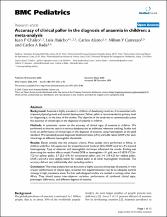Accuracy of clinical pallor in the diagnosis of anaemia in children: a meta-analysis

View/
Trabajo
(application/pdf: 4.804Mb)
(application/pdf: 4.804Mb)
Date
2005-12-08Author(s)
Chalco, Juan P.
Huicho, Luis
Alamo, Carlos
Carreazo, Nilton Y.
Bada, Carlos A.
Metadata
Show full item recordAbstract
Background
Anaemia is highly prevalent in children of developing countries. It is associated with impaired physical growth and mental development. Palmar pallor is recommended at primary level for diagnosing it, on the basis of few studies. The objective of the study was to systematically assess the accuracy of clinical signs in the diagnosis of anaemia in children.
Methods
A systematic review on the accuracy of clinical signs of anaemia in children. We performed an Internet search in various databases and an additional reference tracking. Studies had to be on performance of clinical signs in the diagnosis of anaemia, using haemoglobin as the gold standard. We calculated pooled diagnostic likelihood ratios (LR's) and odds ratios (DOR's) for each clinical sign at different haemoglobin thresholds.
Results
Eleven articles met the inclusion criteria. Most studies were performed in Africa, in children underfive. Chi-square test for proportions and Cochran Q for DOR's and for LR's showed heterogeneity. Type of observer and haemoglobin technique influenced the results. Pooling was done using the random effects model. Pooled DOR at haemoglobin <11 g/dL was 4.3 (95% CI 2.6–7.2) for palmar pallor, 3.7 (2.3–5.9) for conjunctival pallor, and 3.4 (1.8–6.3) for nailbed pallor. DOR's and LR's were slightly better for nailbed pallor at all other haemoglobin thresholds. The accuracy did not vary substantially after excluding outliers.
Conclusion
This meta-analysis did not document a highly accurate clinical sign of anaemia. In view of poor performance of clinical signs, universal iron supplementation may be an adequate control strategy in high prevalence areas. Further well-designed studies are needed in settings other than Africa. They should assess inter-observer variation, performance of combined clinical signs, phenotypic differences, and different degrees of anaemia.
Collections
- Artículos [274]
Subject
Publisher
BMC
Rights
info:eu-repo/semantics/openAccess







